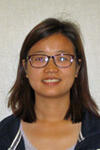Dandan Ji
Ph.D. 2019, Yale University
We test the ability of a general low-dimensional model for turbulence to predict geometry-dependent dynamics of large-scale coherent structures, such as convection rolls. The model consists of stochastic ordinary differential equations, which are derived as a function of boundary geometry from the Navier-Stokes equations. The model describes the motion of the LSC in terms of diffusion in a potential. We test the model using Rayleigh-Bénard convection experiments in a cubic container, in which there is a single convection roll known as the large-scale circulation (LSC). The model predicts an oscillation mode in which the LSC oscillates around a corner. To characterize the dynamics of the large-scale circulation in a cube, we report values of diffusivities and damping time scales for both the LSC orientation $\theta_0$ and temperature amplitude, and of the mean temperature amplitude, for $8\times10^7 \le Ra \le 3\times 10^9$. We show that the potential for the orientation $\theta_0$ and slosh angle $\alpha$ has quadratic minima near each corner, with curvature about a factor of 2 smaller than predicted. The potential is nearly symmetric in $\theta_0$ and $\alpha$ near the corners as predicted, indicating the 2 parameters are uncoupled. The prediction of the natural frequency $\omega_r$ of the potential was too large by factor of 2.5, which is typical of this model. We observed a new oscillation mode around corners of the cell above a critical Ra $=5.\times10^8$. This critical Ra, appears in the model as a crossing of an underdamped-overdamped transition. The oscillation period, power spectrum, and critical Ra for oscillations, are consistent with the model if we adjust the model parameters by about a factor of 2. The uncertainty of a factor of 2 in model parameters is too large to correctly predict whether resonance exists. The structure of the oscillation mode consisted of oscillations in $\theta_0$ and $\alpha$ each around the same corner. The structure of the oscillation of $\hat \theta_0$ is consistent with the predicted $n = 1$ advected oscillation mode, the oscillation in $\hat \alpha$ is not quite that of the prediction. The observed oscillation in $\alpha_b$ is consistent with the prediction of $n = 1$, oscillation in $\alpha_t$ is having the consistent phase shift but the opposite correlation as the prediction, and there is oscillation in $\alpha_m$ while the prediction is 0. The observed oscillation is more complex. Since the model was developed in a cylindrical geometry, the continued success of the model at predicting the potential and its relation to other flow properties in a cubic geometry – which has very different flow modes – still suggests great promise for the potential to predict the dynamics of large-scale coherent structures in complicated geometries. However, the failure to predict the complexity of the oscillation structure indicates the need for a more complex model.
The model also predicts that in the cubic container, where there are 4 potential wells created by the geometry, the orientation of a convection roll crosses a potential barrier stochastically. We observe stochastic switching between diagonals of the cubic cell. The measured switching rate is within 30\% of the prediction $Ra = 4.8\times10^8$. We also investigate the tilt-induced potential in the cubic cell. We find that even a change of $\0.03\pm0.02^\circ$ in the tilting angle could cause the breaking of the symmetry of in temperature profile. We successfully model the shape of the tilt-induced potential, although the magnitude of the prediction is 1.7 orders of magnitude smaller than the measurement.
We further extend the model to the two coupled cubic cell. Using the predicted the functional form of the interaction-induced potential, we measure the magnitude from the experiment and then add the interaction-induced potential to the model. We show that there are two stable states, counter- and co- rotating state. The counter- and co-rotating states are not perfectly two-dimensional, but in each case there are two preferred orientations symmetrically distributed around the centerline, which the system can stochastically switch between. The transition between two states is measured within the range of $\beta = 1^\circ$ and $\beta = 2^\circ$, which is an order of magnitude smaller than the prediction. Reversal from co-rotating state(preferred) to counter-rotating state(unpreferred) and back to co-rotating state is observed in the experiment at $\beta = -1.42 ^\circ$. We find that from the preferred state to the unpreferred state, $\delta$ of the cell which switches the direction decreases, which is similar to the reversal event observed in the cylinder. We compare the switching rate of the measurement to the prediction by the conditional potential, we find for the double-well potential, the measurement is consistent with the prediction within the error bar; for the single-well potential, the measurement rate is an order of magnitude off from the prediction. It’s possible that Kramers’s approximation is no longer valid in the single-well calculation. The measured dependence of the LSC orientations in the two cells on $\beta$ is qualitatively agree with the prediction for both the counter and co rotating state. We test the measurement of the strength of the LSC $\delta(\beta)$ against the prediction. For the counter-rotating state, the measurement agrees with the model prediction, in the case of the co-rotating state, the slope on $\beta$ dependence from the measurement is 3 times smaller, and $\delta_1$ is bigger than $\delta_2$ by at least $0.0274 \pm 0.0005 ^\circ C$, which disagrees with the model. As to the width of the distribution of the strength $\sigma(\beta)$, the measurement is 4.7 times smaller than the prediction. The success of the model in the switching rate prediction and the general shape prediction indicate the model is promising for applications in coupled-cell geometries. The failure in the prediction on the magnitude suggests that the coupled-cell may have extra source of potentials that have not been considered, such as the location of where the interaction of the two LSC happens.
